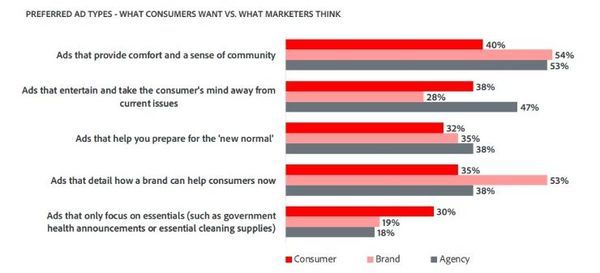หลาย ๆ ประเทศเริ่มผ่อนคลายมาตรการเก็บตัวอยู่บ้าน บริษัทต่างๆ ก็เริ่มมองหาหนทางที่จะทำตลาดกับลูกค้าในรูปแบบที่สอดรับกับวิถีใหม่ ขณะที่เศรษฐกิจอยู่ในช่วงขาลง แต่บริษัทต่างๆ ยังต้องตัดสินใจว่าควรจะลงโฆษณาเพื่อเข้าถึงกลุ่มลูกค้าเป้าหมายหรือไม่ อย่างไรก็ตาม ข้อมูลเชิงลึกที่ได้รับจากช่วงเศรษฐกิจถดถอยก่อนหน้านี้ทำให้เราทราบว่าการระงับ หรือยุติการโฆษณาไม่ใช่ทางเลือกที่ยั่งยืนสำหรับแบรนด์ต่างๆ ที่พยายามฟันฝ่าวิกฤตในครั้งนี้อย่างแน่นอน
ในช่วงภาวะเศรษฐกิจถดถอยเมื่อปี 2551 จอห์น เควลช์ ได้เขียนบทความเรื่อง “วิธีการทำตลาดในช่วงธุรกิจขาลง” (How to Market in a Downturn) ตีพิมพ์ในนิตยสาร Harvard Business Review โดยระบุว่า “แม้ว่าการลดค่าใช้จ่ายอาจเป็นเรื่องสำคัญ แต่ถ้าหากไม่สามารถส่งเสริมแบรนด์ หรือไม่ทำการตรวจสอบความต้องการที่เปลี่ยนแปลงไปของลูกค้ากลุ่มหลักๆ ก็อาจลดทอนประสิทธิภาพการดำเนินงานในระยะยาวได้”
ภาวะเศรษฐกิจถดถอยทำให้เกิดยอดขายที่หดหาย เพราะผู้บริโภคประสบปัญหาด้านการเงิน ด้วยเหตุนี้ Adobe Advertising Cloud จึงดำเนินการสำรวจความคิดเห็นของผู้บริโภคทั่วโลกกว่า 1,000 คน รวมถึงนักการตลาดของแบรนด์ต่างๆ กว่า 500 คน เพื่อตรวจสอบมุมมองและความคิดเห็นที่มีต่อโฆษณาในปัจจุบัน รวมไปถึงการตอบสนองของแบรนด์ต่างๆ สิ่งที่ผู้บริโภคต้องการ และสิ่งที่ไม่ต้องการ รวมถึงโอกาสสำหรับนักการตลาดในการสร้างความสำเร็จที่ยั่งยืน
ข้อมูลสำคัญที่ได้รับจากการสำรวจมีดังนี้:
ผู้บริโภคยังคงต้องการดูโฆษณา แบบเจาะจงกลุ่มเป้าหมาย: เกือบ 90% ของผู้ตอบแบบสอบถามต้องการดูโฆษณาแบบเจาะจงกลุ่มเป้าหมายที่มีประโยชน์และสอดรับกับความต้องการของพวกเขา
ผู้บริโภคกลุ่ม Gen Z ยังคงเป็นกลุ่มเป้าหมายสำหรับแบรนด์หรู: เมื่อเปรียบเทียบระหว่างคนรุ่นต่างๆ พบว่าคนรุ่น Gen Z มีความต้องการดูโฆษณาแบรนด์ที่หรูหรามากที่สุด โดยกว่า 40% ของผู้บริโภคกลุ่ม Gen Z ต้องการดูโฆษณาของแบรนด์หรูหรา หรือสินค้าที่ไม่ได้จำเป็นต่อการดำรงชีวิต ทั้งๆ ที่คนกลุ่ม Gen Z เป็นกลุ่มที่ได้รับผลกระทบมากที่สุดจากปัญหาเศรษฐกิจที่สืบเนื่องมาจากวิกฤตโควิด-19
ผู้ชายที่เป็นคนรุ่นมิลเลนเนียล (Millennial) และพนักงานประจำมียอดใช้จ่ายเพิ่มขึ้น: กว่าครึ่งหนึ่งของผู้ชายที่เป็นคนรุ่นมิลเลนเนียลจับจ่ายใช้สอย และซื้อสินค้าทางออนไลน์เพิ่มมากขึ้น เมื่อเทียบกับช่วงก่อนการแพร่ระบาด และเกือบครึ่งหนึ่ง (48%) ของผู้บริโภคทั้งหมดที่มีงานประจำก็มียอดใช้จ่ายเพิ่มขึ้นเช่นกัน แบรนด์ที่เจาะกลุ่มเป้าหมายนี้จึงมีแนวโน้มที่จะประสบความสำเร็จ
หยุดการโฆษณา ‘เราพร้อมอยู่เคียงข้างคุณเสมอ’: นักการตลาดของแบรนด์ต่างๆ เชื่อว่าผู้บริโภคต้องการดูโฆษณาที่แสดงให้เห็นว่าแบรนด์นั้นๆ ทำกิจกรรมเพื่อสังคมและ ‘ช่วยเหลือ’ ประชาชนอย่างไร แต่ในความเป็นจริงแล้ว นักการตลาดเชื่อเรื่องนี้มากกว่าผู้บริโภคทั่วไปเกือบ 20% ดังนั้นอาจถึงเวลาแล้วที่จะหยุดโฆษณาที่เกี่ยวกับการทำกิจกรรมเพื่อสังคมในช่วงโควิด-19 และหันมาให้ความสนใจกับ “สิ่งจำเป็นต่อการดำเนินชีวิตและทำให้ผู้คนผ่อนคลาย” จากวิกฤตนี้
สื่อที่เป็น visual มียอดเพิ่มขึ้นอย่างมาก: ทีวีและวิดีโอที่เชื่อมต่ออินเทอร์เน็ตมีงบประมาณโฆษณาเพิ่มขึ้นโดยเฉลี่ย 32% ตามข้อมูลจากนักการตลาดของแบรนด์ต่างๆ ควรโฆษณาสินค้าให้มากขึ้น: สองในสามของชาวอเมริกันหันไปดูคอนเทนต์แบบคิดค่าบริการกันมากขึ้นเมื่อเทียบกับช่วงก่อนการแพร่ระบาด แต่ค่าโฆษณากลับลดลงอย่างมาก ส่วนแบรนด์ที่เจาะกลุ่มเป้าหมายผู้ใหญ่หรือผู้ชมที่เป็นคนรุ่นเก่าควรจะลงโฆษณาในเว็บไซต์ข่าวที่อาจนำเสนอข้อมูลเกี่ยวกับสถานการณ์โควิด เพราะคนกลุ่มนี้แทบไม่มีแนวโน้มที่จะเชื่อมโยงแบรนด์เข้ากับข้อมูลข่าวสารแง่ลบ
ควรนำเสนอแบรนด์ใหม่ๆ: ถ้าแบรนด์สามารถตอบโจทย์ความต้องการได้อย่างลงตัว ผู้บริโภค 56% ก็มีแนวโน้มที่จะยอมรับแบรนด์นั้นๆ แม้ว่าเขาไม่เคยได้ยินชื่อของแบรนด์ดังกล่าวมาก่อนที่จะเกิดสถานการณ์โควิด แบรนด์ที่ใช้ประโยชน์จากแพลตฟอร์มประสบการณ์ลูกค้า (Customer Experience Platform) จะมีความได้เปรียบอย่างเห็นได้ชัดสำหรับการปรับเปลี่ยนแนวทางการโฆษณาให้สอดรับกับวิถีใหม่ ตัวอย่างเช่น สามารถอัพเดตโปรไฟล์ลูกค้าได้อย่างละเอียดโดยอาศัยข้อมูลเรียลไทม์เกี่ยวกับพฤติกรรมการซื้อ ซึ่งจะช่วยให้นักการตลาดมีข้อมูลที่ทันสมัยในการเลือกกลุ่มเป้าหมายของแคมเปญโฆษณา การใช้ข้อมูลเพื่อทำความเข้าใจเกี่ยวกับลูกค้า รวมถึงปัญหาท้าทายที่ลูกค้าพบเจอ จะช่วยให้แบรนด์ต่างๆ รู้ว่าควรจะออกโฆษณาแบบใด และควรจะลงโฆษณาบนเว็บไซต์ใดบ้างเพื่อให้เข้าถึงกลุ่มเป้าหมาย นอกจากนี้แบรนด์เหล่านี้จะสามารถจัดการแอสเซ็ทต่างๆ สร้างสรรค์ประสบการณ์สำหรับผู้ใช้ และนำเสนอโฆษณาที่สอดคล้องกัน ตั้งแต่ขั้นตอนของการคิดไอเดียไปจนถึงการดำเนินการ และขั้นตอนอื่นๆ ทั้งหมดนี้นับว่ามีความสำคัญอย่างมากต่อบริษัทต่างๆ ในการส่งเสริมแบรนด์ที่สอดรับกับความต้องการของผู้บริโภค
การยุติการโฆษณาอย่างสิ้นเชิงไม่ใช่ทางเลือกที่ดีนัก ไม่ว่าคุณจะต้องการมากเพียงใดก็ตาม ทางที่ดีคุณควรปรับเปลี่ยนกลยุทธ์หรือแนวทาง การวิเคราะห์ข้อมูลและการสร้างโปรไฟล์ลูกค้าที่ละเอียดจะช่วยให้บริษัทที่ลงโฆษณาประสบความสำเร็จทั้งในระยะสั้นและระยะยาวโดยใช้วิธีเจาะกลุ่มเป้าหมายอย่างตรงจุด เป็นที่ทราบกันดีว่าการนำเสนอประสบการณ์ไม่ใช่แนวทางแบบครอบจักรวาล เช่นเดียวกับโฆษณาสถานการณ์โควิด-19 ตอกย้ำให้เห็นถึงความจำเป็นในการใช้แนวทางการปรับแต่งแบบเฉพาะบุคคล (Personalization) เพิ่มมากขึ้น รวมถึงการติดต่อสื่อสารกับลูกค้าแบบเรียลไทม์ และการนำเสนอข้อมูลข่าวสารที่สอดคล้องกับความต้องการของลูกค้าอย่างต่อเนื่อง
คลิกที่นี่เพื่ออ่านข้อมูลเพิ่มเติมและดาวน์โหลดแนวทางกลยุทธ์ที่อ้างอิงการสำรวจและนำเสนอมาตรการที่นำไปใช้ได้จริงในทางปฏิบัติสำหรับการลงโฆษณาในช่วงสถานการณ์โควิด และช่วงเศรษฐกิจขาลง
